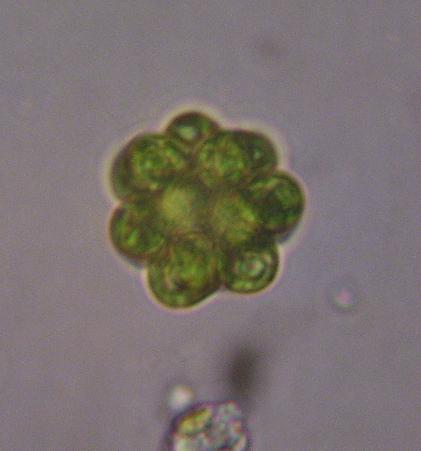|
Coelastrum Pulchrum
''Coelastrum'' is a genus of green algae in the Scenedesmaceae family. It is a common component of the phytoplankton in freshwater habitats such as ponds, lakes, waterfalls, and temporary pools of water, particularly eutrophic ones. The genus has a more or less cosmopolitan distribution, although some species appear to have more restricted geographical distributions. The name comes from the Greek terms ''koilos'', meaning hollow, and ''astron'', meaning star. Description ''Coelastrum'' consists of round colonies of cells (termed coenobium (morphology), coenobia) of 4, 8, 16, 32, or 64 cells. Cells are spherical to polygonal, and are connected to each other via extensions of their cell walls to form hollow spheres. The cells may have various ornamentation such as protuberans, and have one parietal chloroplast with a single pyrenoid. ''Coelastrum'' reproduces asexual reproduction, asexually. Prior to reproduction, cell nuclei undergo mitosis, forming multinucleate cells. The cell t ... [...More Info...] [...Related Items...] OR: [Wikipedia] [Google] [Baidu] |
Coenobium (morphology)
Coenobium or coenobia may refer to : * Cenobitic monasticism (cenobium, cenobite), a monastic community in a tradition stressing communal life, as opposite to eremitism * Coenobium (morphology), a colony of cells, notably in algae * Coenobia (moth), ''Coenobia'' (moth) {{dab ... [...More Info...] [...Related Items...] OR: [Wikipedia] [Google] [Baidu] |
Mucilage
Mucilage is a thick gluey substance produced by nearly all plants and some microorganisms. These microorganisms include protists which use it for their locomotion, with the direction of their movement always opposite to that of the secretion of mucilage. It is a polar glycoprotein and an exopolysaccharide. Mucilage in plants plays a role in the storage of water and food, seed germination, and thickening membranes. Cacti (and other succulents) and flax seeds are especially rich sources of mucilage. Occurrence Exopolysaccharides are the most stabilising factor for microaggregates and are widely distributed in soils. Therefore, exopolysaccharide-producing "soil algae" play a vital role in the ecology of the world's soils. The substance covers the outside of, for example, unicellular or filamentous green algae and cyanobacteria. Amongst the green algae especially, the group Volvocales are known to produce exopolysaccharides at a certain point in their life cycle. It occu ... [...More Info...] [...Related Items...] OR: [Wikipedia] [Google] [Baidu] |
Coelastrum Chodatii
''Coelastrum'' is a genus of green algae in the Scenedesmaceae family. It is a common component of the phytoplankton in freshwater habitats such as ponds, lakes, waterfalls, and temporary pools of water, particularly eutrophic ones. The genus has a more or less cosmopolitan distribution, although some species appear to have more restricted geographical distributions. The name comes from the Greek terms ''koilos'', meaning hollow, and ''astron'', meaning star. Description ''Coelastrum'' consists of round colonies of cells (termed coenobia) of 4, 8, 16, 32, or 64 cells. Cells are spherical to polygonal, and are connected to each other via extensions of their cell walls to form hollow spheres. The cells may have various ornamentation such as protuberans, and have one parietal chloroplast with a single pyrenoid. ''Coelastrum'' reproduces asexually. Prior to reproduction, cell nuclei undergo mitosis, forming multinucleate cells. The cell then undergoes cytokinesis and a new daughte ... [...More Info...] [...Related Items...] OR: [Wikipedia] [Google] [Baidu] |
Eutrophication
Eutrophication is a general term describing a process in which nutrients accumulate in a body of water, resulting in an increased growth of organisms that may deplete the oxygen in the water; ie. the process of too many plants growing on the surface of a river, lake, etc., often because chemicals that are used to help crops grow have been carried there by rain. Eutrophication may occur naturally or as a result of human actions. Manmade, or cultural, eutrophication occurs when sewage, Industrial wastewater treatment, industrial wastewater, fertilizer runoff, and other nutrient sources are released into the environment. Such nutrient pollution usually causes algal blooms and bacterial growth, resulting in the depletion of dissolved oxygen in water and causing substantial environmental degradation. Many policies have been introduced to combat eutrophication, including the United Nations Development Program (UNDP)'s sustainability development goals. Approaches for prevention and re ... [...More Info...] [...Related Items...] OR: [Wikipedia] [Google] [Baidu] |
Paleoecology
Paleoecology (also spelled palaeoecology) is the study of interactions between organisms and/or interactions between organisms and their environments across geologic timescales. As a discipline, paleoecology interacts with, depends on and informs a variety of fields including paleontology, ecology, climatology and biology. Paleoecology emerged from the field of paleontology in the 1950s, though paleontologists have conducted paleoecological studies since the creation of paleontology in the 1700s and 1800s. Combining the investigative approach of searching for fossils with the theoretical approach of Charles Darwin and Alexander von Humboldt, paleoecology began as paleontologists began examining both the ancient organisms they discovered and the reconstructed environments in which they lived. Visual depictions of past marine and terrestrial communities have been considered an early form of paleoecology. The term "paleo-ecology" was coined by Frederic Clements in 1916. Overview of ... [...More Info...] [...Related Items...] OR: [Wikipedia] [Google] [Baidu] |
Wastewater Treatment
Wastewater treatment is a process which removes and eliminates contaminants from wastewater. It thus converts it into an effluent that can be returned to the water cycle. Once back in the water cycle, the effluent creates an acceptable impact on the environment. It is also possible to reuse it. This process is called Reclaimed water, water reclamation. The treatment process takes place in a wastewater treatment plant. There are several kinds of wastewater which are treated at the appropriate type of wastewater treatment plant. For domestic wastewater the treatment plant is called a Sewage Treatment. Municipal wastewater or sewage are other names for domestic wastewater. For industrial wastewater, treatment takes place in a separate Industrial wastewater treatment, or in a sewage treatment plant. In the latter case it usually follows pre-treatment. Further types of wastewater treatment plants include Agricultural wastewater treatment and leachate treatment plants. One common proce ... [...More Info...] [...Related Items...] OR: [Wikipedia] [Google] [Baidu] |
Astaxanthin
Astaxanthin is a keto- carotenoid within a group of chemical compounds known as carotenoids or terpenes. Astaxanthin is a metabolite of zeaxanthin and canthaxanthin, containing both hydroxyl and ketone functional groups. It is a lipid-soluble pigment with red coloring properties, which result from the extended chain of conjugated (alternating double and single) double bonds at the center of the compound. The presence of the hydroxyl functional groups and the hydrophobic hydrocarbons render the molecule amphiphilic. Astaxanthin is produced naturally in the freshwater microalgae '' Haematococcus pluvialis,'' the yeast fungus ''Xanthophyllomyces dendrorhous'' (also known as ''Phaffia rhodozyma'') and the bacteria '' Paracoccus carotinifaciens.'' When the algae are stressed by lack of nutrients, increased salinity, or excessive sunshine, they create astaxanthin. Animals who feed on the algae, such as salmon, red trout, red sea bream, flamingos, and crustaceans (shrimp, kri ... [...More Info...] [...Related Items...] OR: [Wikipedia] [Google] [Baidu] |
Biotechnology
Biotechnology is a multidisciplinary field that involves the integration of natural sciences and Engineering Science, engineering sciences in order to achieve the application of organisms and parts thereof for products and services. Specialists in the field are known as biotechnologists. The term ''biotechnology'' was first used by Károly Ereky in 1919 to refer to the production of products from raw materials with the aid of living organisms. The core principle of biotechnology involves harnessing biological systems and organisms, such as bacteria, yeast, and plants, to perform specific tasks or produce valuable substances. Biotechnology had a significant impact on many areas of society, from medicine to agriculture to environmental science. One of the key techniques used in biotechnology is genetic engineering, which allows scientists to modify the genetic makeup of organisms to achieve desired outcomes. This can involve inserting genes from one organism into another, and con ... [...More Info...] [...Related Items...] OR: [Wikipedia] [Google] [Baidu] |
Subfamily
In biological classification, a subfamily (Latin: ', plural ') is an auxiliary (intermediate) taxonomic rank, next below family but more inclusive than genus. Standard nomenclature rules end botanical subfamily names with "-oideae", and zoological subfamily names with "-inae". Detarioideae is an example of a botanical subfamily. Detarioideae is a subdivision of the family Fabaceae (legumes), containing 84 genera. Stevardiinae is an example of a zoological subfamily. Stevardiinae is a large subdivision of the family Characidae, a diverse clade In biology, a clade (), also known as a Monophyly, monophyletic group or natural group, is a group of organisms that is composed of a common ancestor and all of its descendants. Clades are the fundamental unit of cladistics, a modern approach t ... of freshwater fish. See also * International Code of Nomenclature for algae, fungi, and plants * International Code of Zoological Nomenclature * Rank (botany) * Rank (zoolo ... [...More Info...] [...Related Items...] OR: [Wikipedia] [Google] [Baidu] |





